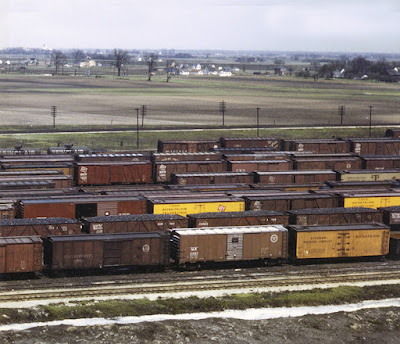I posted a discussion last month about the model railroading operation-cycle problem of confiscating empty cars, when a system of paired paperwork for loads and empties is in use. I included some ideas about how to “break” that empty-load cycle if already in existence. That post can be found here: https://modelingthesp.blogspot.com/2022/02/waybills-part-94-handling-confiscation.html .
In the present post, I want to say a little more about empty cars in model layout operation, specifically the issue of car flow. As with that previous post, the issue arises if one has in use a car-card or waybill system that matches loaded and empty paperwork in one packet.
Though that arrangement is convenient, and effective in moving a car to and from staging, one has to face the issue of car flow. How often does such a car movement cycle happen at each industry? This is the essence of car flow.
I have written several previous blog posts about car flow. One was a general one (which you can find at this link: https://modelingthesp.blogspot.com/2016/09/car-flow-for-operating-session.html ). Way back in 2011, I also wrote a more detailed account of a method I have used to formalize how car flow works (here’s a link to the second of the two posts about that topic: https://modelingthesp.blogspot.com/2011/11/operations-demand-based-car-flow-2.html ).
The key point is to ensure that industries that receive empty cars for loading get a regular supply of them (and what “regular” means will vary from industry to industry). This is effectively the reverse of the familiar situation in which a load is delivered to an industry, and later the empty car is picked up and sent on its way.
Of course most of our model freight cars are not obviously empty, any more than are most prototype cars. I can make that point with this often-published 1943 photo from the Library of
Congress, showing a Milwaukee Road yard in the Chicago area (I believe
Bensenville). You can see two empty gondolas, several gondolas loaded
with coal, and at least two box cars with doors ajar, thus likely empty.
None of the rest of the cars give you any clue as to whether they are
loaded or not. But our model paperwork can indeed tell us which cars are
which.
The essential point to be made here is that any operating scheme for a layout has to manage the flow of empty cars as well as loads. On my layout nowadays, the primary tool is the Actions list, as I described in a post awhile back (see it at: https://modelingthesp.blogspot.com/2019/07/waybills-part-66-car-movement-system.html ). This list, an example of which is shown in that post, identifies all “actions” (car movements) in a session. But more important in the present context, a set of successive lists provides a record of previous sessions.
With that in hand, and any kind of overall operating plan for car flow (for example the system described in the post already cited: https://modelingthesp.blogspot.com/2011/11/operations-demand-based-car-flow-2.html ), the layout owner can managed the car flow to the degree desired, and always has a reference point for any future session.
One situation I have long tried to deal with effectively is the industry that doesn’t ship very often, and thus doesn’t often get empty cars to load. Here’s an example, as Alco switcher SP 1389 in East Shumala is spotting a T&NO box car at C.J. Riley & Sons for loading. As the season is spring, the cargo is likely wool. But this small warehouse company doesn’t ship much by rail, so this is far from an event of every session.
As I asccumulate more and more operating sessions on my layout, issues like this continue to pose interesting challenges, in planning how to manage car flow. Of course, most visiting operators aren’t aware of this, because few of my operators even come to every session, and sessions are spaced out in time. But I know the patterns, and I want them to be realistic ones. That’s my purpose in worrying about car flow from session to session.
Tony Thompson


Another strike against the traditional 4-cycle waybill. I've been working on this issue of flow, or waybill frequency, for some years as well. On a smaller, home layout it can almost come down to the owner tracking it mentally or through lists as you suggest. I'm curious about systems that will scale to larger or more complex layouts though - especially if it doesn't require a computer algorithm. Great food for thought here, as usual. Thank you!
ReplyDeleteYou're welcome, Brian. I don't think I have really solved the problem yet, but I'm doing better as time goes by.
DeleteTony Thompson